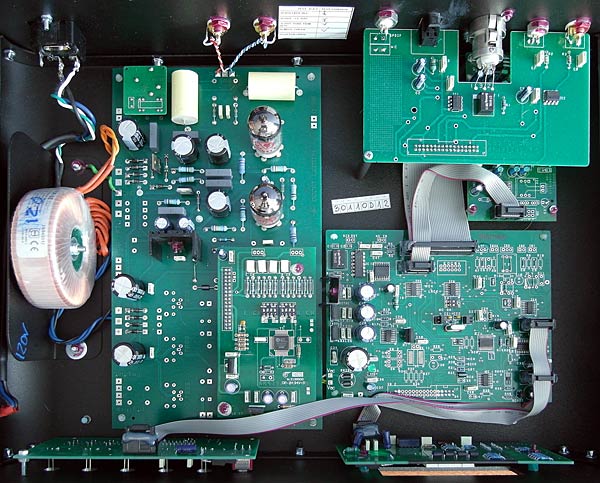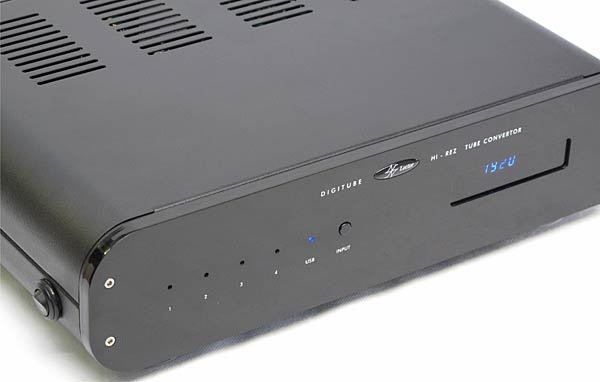| Columns Retired Columns & Blogs |
What does this mean? That the "absolute sound" of a component is all that matters? Horrid measurements have no effect on what some of the best ears in the business can perceive? Yikes!
For all that, the Lector's greatest strength—which proved consistently impressive with classical fare—was how it allowed voices and instruments to emerge with their timbral colors intact. We can argue all day about the subtle minutiae of the color "correctness" exhibited by this or any other playback device—an argument that holds little interest for me up until deviations from the norm get really hairy—but the fact is, in this era of digital and analog playback gear that sounds bleached of all flesh and blood, a product capable of this degree of color saturation is a beautiful thing. So it was when I auditioned the XRCD remastering of Ravel's Pavane for a Dead Princess, recorded in 1957 by Fritz Reiner and the Chicago Symphony Orchestra (ripped from CD, JVC JVCXR-0215-2). As with Kaplan's Mahler, the Digitube honored pizzicato strings in a manner that was beyond either the Halide or the somewhat older Wavelength Proton converter. Yet it also did a gorgeous job with massed violins—which have, in that recording, a sheen that I associate with RCA's orchestral recordings of that era—and it did a spine-tinglingly convincing job with the timbres throughout the woodwind section.

Yet another Mahler recording—my current favorite version of Symphony 6, by Pierre Boulez and the Vienna Philharmonic (ripped from CD, Deutsche Grammophon 445 835-2)—showed the Digitube at its best. The first thing that impressed me, after the believable power and impact of the opening chords, was the richly textured string sound, every voice announcing its presence with rosiny realism—or so it seemed. I admit, there were moments when I wondered if the Digitube might have been exaggerating some textures. The side drum, for example, while put across with wonderful impact and color, also sounded very slightly fuzzy during some rolls. I was also a bit puzzled by the way the Lector reproduced the brass in this recording, which, despite the Lector's extended treble, sounded darker than through the Halide; the less expensive converter afforded those instruments their full measure of glow. Go figure.
In spite of its classical sympathies, the Lector Digitube also performed well with rock and pop recordings. The electric bass in "Marrakesh Express," from Crosby, Stills & Nash (192kHz file, Atlantic), sounded deep, colorful, and tight, and the same was true of Paul McCartney's great bass line in "I Am the Walrus," ripped from the Beatles' Magical Mystery Tour, from The Beatles in Mono (CD, Apple 5099969945120)—although with that remastering and other mono recordings the Lector was again bested by the Halide DAC HD in terms of scale. "Money Becomes King," from Tom Petty's The Last DJ (ripped from CD, Warner Bros. 48396-2), sounded sensationally good. The Lector brought out from this nice if somewhat plasticky recording more impact, detail, color, and involvement than did the superb Halide—compared to which, the Lector also did a superior job of separating the sounds of various instruments during the louder, more cluttered passages.

Still, it never got better than when I used the Digitube converter to play Charles Neidich and the Juilliard String Quartet's recording of the Brahms Clarinet Quintet, Op.115 (ripped from CD, Sony S2K 66285), the Lector delivering a near-analog portrayal of not just the colors and textures of the instruments but also the dramatic shadings—especially in the clarinet's stormier runs, after the switch back to the home key of B minor; the Halide sounded plasticky by comparison. The Lector went even further, reproducing a perfect and subtle envelope—almost a halo—of room sound around the gentle, final B major chord: a delightful and very satisfying moment that, better than anything else, sums up this product's musicality and charm.
Conclusions
I thoroughly enjoyed my time with the Lector Digitube S-192. I liked its distinctive yet non-overcooked appearance, its build quality, its flexibility, and, above all, the manner in which it played music. Its flaws, such as they were, meshed well with my own preferences in music playback, its strengths even more so.
Even at its reasonable price of $3595, the Lector faces strong competition, the most obvious being from the Ayre Acoustics QB-9 ($3250). Experience suggests that the USB-only Ayre offers a shade more clarity and openness, at the expense of far less flexibility in input options; the Lector delivers timbral color and texture in greater abundance, at the expense of many more input options than some enthusiasts wish to pay for. Both are compatible with the highest-resolution digital downloads presently available (footnote 3). A dealer who has both products in stock and is willing to make an overnight loan would be worth seeking out (my attempt at an understatement). Pending such good luck, I can heartily recommend Lector Strumenti Audio's Digitube S-192 for the musicality it displayed in my system, as well as for its attractive casework and its good value for the money.

What does this mean? That the "absolute sound" of a component is all that matters? Horrid measurements have no effect on what some of the best ears in the business can perceive? Yikes!

I think something is misconfigured. I have never seen or measured an AKM device that was so far from correct operation. You can see measured results for the chip here: http://www.akm.com/akm/en/file/ev-board-manual/AK4397EQ.pdf Everything indicates a problem with the board or with the specific device.
Is it possible that the analog electronics could be the cause of the non-linearity? It seems unlikely but getting the digital side so misconfigured and still working is not easy.
Obviously non-linearity at -90 dB doesn't scream at reviewers saying "I sound bad!" but MP3's demonstrated how much audio can be removed and still have "decent" audio.

FWIW, in the "Manufacturers' Comments" section, Lector Strumenti's US representative states that the designer "deliberately sacrifices measured performance to achieve his design objectives, the most obvious one being superior musicality" and seems not to think that the measurements are unexpected.

I read the comment. Looks like a well written manufacturer damage control comment that just regurgitates a number of adjectives from the subjective review (which more likely demonstrates hearing limitations).
Good for John Atkinson to say it as it is. A device that costs a significant chunk of change, that's marketed with big numbers (ooohhh "32 bit DAC from AKM" as seen on the web site, capable of 192kHz and 384kHz) but in reality you'd be wasting dollars feeding this baby >16-bit audio data.
It'd be a shame to think that "musicality" is achieved by sacrificing dynamic range.

..is that in order to make a digital product sound good, you need someone incompetent to design it. Sign me up!

Damage control is not to double down on a bad result. Damage control is normally to attack the measurer or to "discover" on its return that the unit was broken somewhere along the line. Or to announce revisions to the product "since" the review.
This manufacturer has a far more interesting response than damage control.

graph 12 is for sony?
Fig.12 Sony HAP-Z1ES, high-resolution jitter spectrum of analog output signal, 11.025kHz at –6dBFS, sampled at 44.1kHz with LSB toggled at 229Hz: 16-bit internal data (left channel blue, right red). Center frequency of trace, 11.025kHz; frequency range, ±3.5kHz.
and comment is wrong?
maybe this measurement are all fake!
manufacture web site say: setup the dac in service mode for measurement !

graph 12 is for sony?
That's correct and fig.8 is for the MSB Analog DAC. Both are examples of what the measured performance on these tests should look like.
maybe this measurement are all fake!
No, they are not fake. The manufacturer stated that the measurements correctly characterized the product in his published comment.
manufacture web site say: setup the dac in service mode for measurement !
As the reviewer didn't audition the Lector DAC in "service mode," I didn't feel that to be relevant.
John Atkinson
Editor, Stereophile

I think as a matter of testing protocol it would have been better to additionally do the measurements and do some listening in service mode.
For the measurements then we could at least have an inkling whether the manufacturer is even capable of designing gear which will measure conventionally, a pretty important piece of data. Then listening to service mode would possibly indicate whether the manufacturer's choice of poorly measuring configurations actually yielded some audible benefit...in one person's system, at least.
I understand then in terms of workload it's like doing two reviews, though, but I'd be really curious about all this.
(Also, as an aside, in my quite old Camino trying to preview and edit my post twice before hitting "save" results in my getting trapped in an endless loop always returning me to preview mode...even when I do eventually hit "save." Either that or I will have double posted, as happened sometimes with the old messaging system here.)

service mode is for measure test non for listening.
feedback email with manufacture, without service mode setup internnally switch the dac stay in soft mute condition, so the measure are wrong

A claim to be tested as is any other claim about specs from...whom? A manufacturer?
Speaker companies say their speakers have a certain efficiency; then the efficiency of the speakers gets tested.
One mode allegedly measures well. We don't know that. It wasn't tested.
Not too difficult.

You write that the Lector uses 32 bit AK4397 DAC chips.
AK4397 is a 24 bit DAC chip which is obsolete.
If it is in fact a 32 bit chip, then it must be AK4399, which I think is also obsolede by now.
You also describe that the I/V conversion is done discretely with use of only resistors.
This cannot be true, as both AK4397 and AK4399 are both U (voltage) out converters, which in general do not require I/V conversion at all.
Anyways I cannot believe that sound would not be bettered, if the measurable components were optimized.